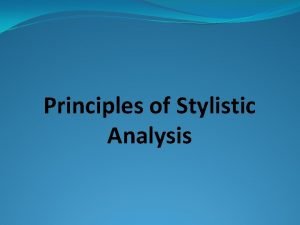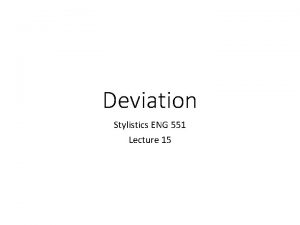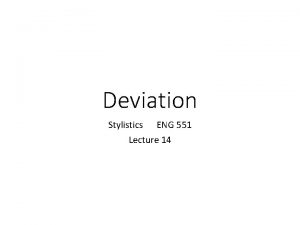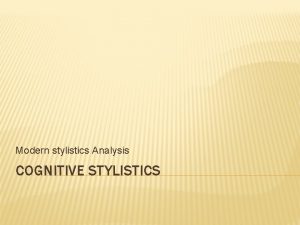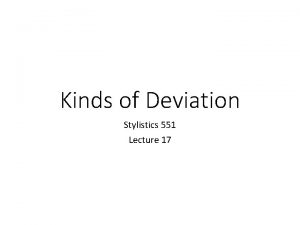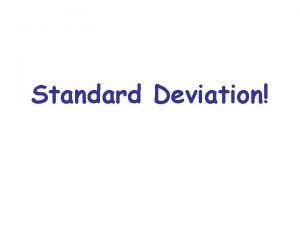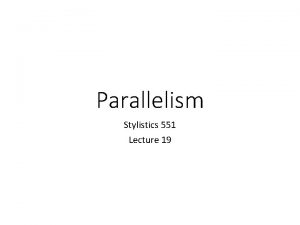Types of Deviation Lecture 16 Stylistics 551 Deviation













- Slides: 13

Types of Deviation Lecture 16 Stylistics 551

Deviation • A linguistic deviation is a disruption of the normal process of communication: it leaves a gap, as it were, in one’s comprehension of text. The gap can be filled, and the deviation rendered significant. But only if by an effort of imagination the reader perceives some deeper connection which compensates for the superficial oddity.

1. The element of Interest: A deviation first of all evokes the interest of the reader. Since a deviation is unusual use of language and expression it appears appealing as the reader finds it different. 2. The Element of Surprise: Surprise is experienced when the reader interprets a deviation and finds out that what apparently appeared unbelievable and or abnormal makes sense at deeper level.

Types of Deviation • There a number of ways to produce foregrounding through deviation in literature. 1. Lexical Deviation 2. Grammatical Deviation 3. Phonological Deviation 4. Graphological Deviation 5. Semantic Deviation 6. Dialectical Deviation 7. Deviation of Register 8. Historical Deviation

Lexical Deviation • When rules of lexis or word formation are broken such deviation is called lexical deviation. In which • Neologism or invention of new words is one of the more obvious ways in which a poet may exceed the normal resources of language. • According to Geoffrey Leech a more correct explanation is that an existing rule (of word formation) is applied with greater generality than its customary. Example: affixation of prefix fore to a verb. Foresee, foretell. And I Tiresias have foresuffered all (Eliot, The Wateland)

Lexical Deviation • The most common processes of word formation are affixation (the affixation of prefix or suffix to an item already in language) • And compounding ( the joining of tow or more items to make a single compound one) Example: The widow-making, unchilding, unfathering deeps. COMPONDING AFFIXATION

Lexical Deviation • Hopkins’s three epithets seem to invest the sea with three aweinspiring qualities. The sea that deprives wives of husbands, children of fathers, parents of children. • The long windedness of this paraphrase reveals the degree of compression and economy which can be achieved by affixation and compounding. • Eliot’s foresufferd is not just a new idea but the encapsulation of a newly formulated idea: that is possible to anticipate mystically the suffering of the future. Just as it is possible to foresee, foretell, forewarn or have knowledge of the future events.

2. Grammatical Deviation • By rules of grammar we mean the rules of syntax. When the rules are broken at grammatical level it is called as grammatical deviation. • A trivial example can be: • I does not be lining she • She cannot be used at the end. Does cannot be used with I, be is also grammatically inappropriate in this sentence.

Grammatical Deviation • A rather different case of misclassification is that which arises in this line form The Wreck of the Deutschland: Thou has bound bones and veins in me, fastened me flesh • the occurrence of the word fastened in the construction into which it does not normally fit. • It is constructed as ‘to make me into flesh by fastening’ • As it seems a grammatical deviation constructed in the pattern of “crown him king”, “cook him dinner” • A rough paraphrase can be “fasten flesh for me”, i. e. for my benefit

3. Phonological Deviation • Patterns of phonology are more on the surface than other forms of deviation. That is why phonological deviation in English poetry is of limited importance. • The irregularities of pronunciation in English poetry are conventional licenses of verse composition. Elision is also an example of phonological deviation. • e. g. noun wind pronounced like verb wind

Graphological Deviation • Also called Orthographic deviation. It involves breaking the rules of punctuation, line arrangement, capitalization etc. • The American poet e. e. cummings is known for his deviant use of punctuation. He discards the capital letters and punctuation where thy are conventionally employed. • For him these become expressive devices, not just symbols to be used according to typographic custom.

Graphological Deviation • If e. e. cummings disregards the orthographic conventions there are poets who use the conventions in an unusual and innovative way. • Emily Dickenson is famous for her use of capitalization and punctuation. • She capitalizes certain words in order to lay emphasis on the ideas. The deviant punctuation marks like dashes contribute to reveal the thoughts of the persona, her hesitation.

Example: e. e cummings me up at does out of the floor quietly Stare a poisoned mouse still who alive is asking What have i done that you wouldn't have
